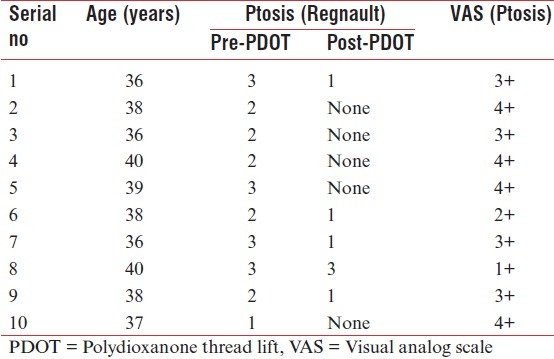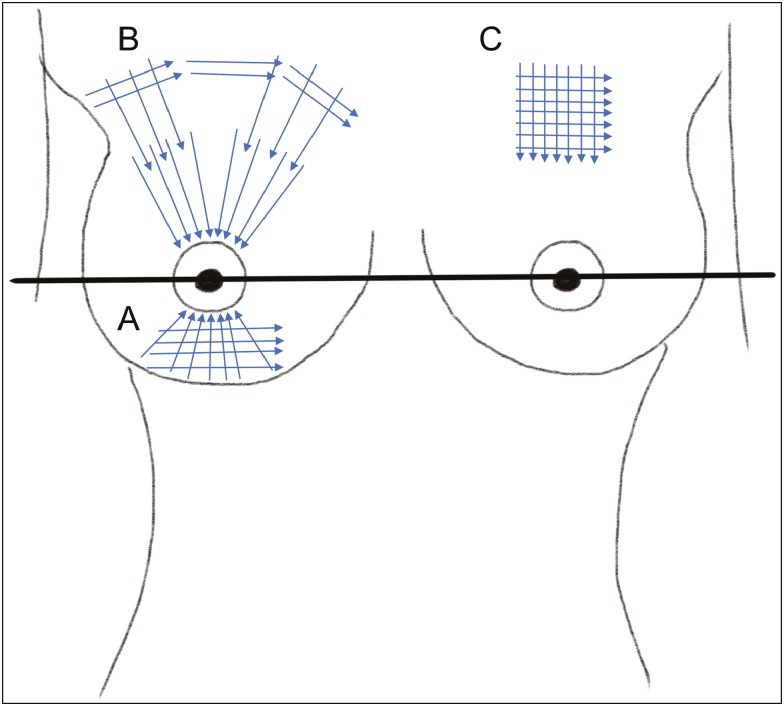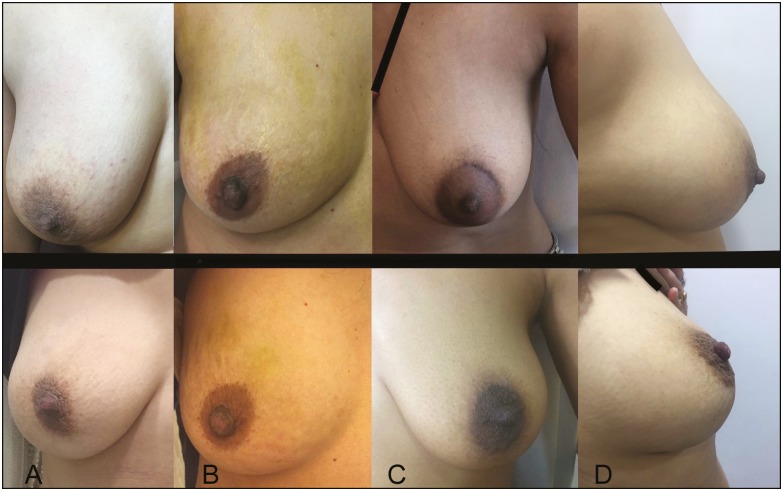Sir,
Female breast ptosis is a consequence of aging. An ideal esthetic nipple lies between 5 and 7cm above the inferior mammary crease in a non-augmented breast. Progressive resting of the gland against the rib cage reflects ptosis. History of significant (50 lbs.) weight loss, higher body mass index (BMI), larger bra cup size, number of pregnancies, and smoking have been described as the significant risk factors for breast ptosis.[1] It is also one of the most common conditions treated by reconstructive surgeons.[2] However, surgical breast reconstructions have their attended surgical risks and associated morbidity, which may be avoidable in lean, younger females, and those with lesser degree of ptosis or mild breast asymmetry. Polydioxanone thread lift (PDOT) offers an alternative to those not desirous of surgery and can also be used as an add-on treatment after surgery for finer correction. It is well established in face-lift procedures; however, literature on breast ptosis use is lacking.[3]
Female patients seeking correction of breast ptosis between January and December 2016 at a dermatology center were selected for management with PDOT (monofilaments, 90mm). Those who were seeking breast volume augmentation, with severe obesity (BMI >40kg/m2), ptosis of grade 3, breast cup size >3, pregnant, and lactating, and those with a history of keloids were excluded. All selected patients underwent a breast examination to rule out preexisting breast disease, were assessed for degree of ptosis as per Regnault ptosis scale [Figure 1] and photographed before and after the procedure, and upon follow-up at 6 months after undergoing PDOT.[4] Preexisting breast disease or any abnormality during the examination was considered contraindication for the procedure. Eutectic mixture of prilocaine and lidocaine was used as a local anesthetic for a period of 1h prior to PDOT under aseptic precautions. We used crosshatch technique for upper pole fullness and inferior to nipple areolar complex, overlapping linear threading for lift along vectors directed at an angle against gravity as well as circular insertion in upper pole for firmness and shaping (scaffolding) [Figure 2]. Posttreatment, all were advised a supportive brassiere for 2 weeks. Patients’ response to treatment was also recorded according to visual analog scale (VAS) (4+, >75% improvement; 3+, 50–75% improvement; 2+, 25–50% improvement; 1+, 0–25% improvement; and no response).
Figure 1.
Regnault ptosis classification; (A) normal, (B) type 1: mild sagging, (C) type 2: moderate sagging, (D) type 3: severe sagging, (E) pseudoptosis: lower breast sagging. *Inferior mammary crease
Figure 2.
PDOT insertion techniques used: (A) crosshatch below nipple areolar complex, (B) scaffolding, (C) crosshatch at upper pole
Ten female patients underwent PDOT insertion and were followed up till 6 months after procedure. The mean pre-procedure ptosis degree was 2.3 and post-procedure was 0.7 [Table 1]. This was statistically significant (P = 0.0002). Eight cases (80%) were satisfied with the procedure outcome (VAS 3+) and one each achieved VAS 2+ and 1+. All were satisfied with the upper pole fullness. Post-procedure bruising was seen as a sequela. No other complications were observed [Figure 3].
Table 1.
Comparison of pre- and posttreatment parameters

Figure 3.
Pre-procedure (top row) and post-procedure (bottom row) of (A) Case 1, (B) Case 3, (C) Case 7, (D) Case 10
Polydioxanone absorbable threads produce instant result, which improves over the initial few weeks, and may last for up to 2 years.[5] Scaffolding, as elaborated earlier, has not been described earlier in thread lift. It provides a better lift for the larger breast volume and its effect lasts longer, as threads are inserted at an angle to the vertical gravity effect, with crossed threads helping in laying down a collagen matrix. Circumferential insertion ensures upper pole definition. As per our experience, a repeat session is needed after 12–15 months.
PDOT is reported to work by stimulating neo-angiogenesis, collagen stimulation, and fibroblast stimulation, which further improves skin texture.[6] The procedure needs considerable expertise with patient selection, correct vector determination, a correct insertion plane within ligaments of Cooper, and repeat sessions to maintain effect as with other esthetic procedures like botulinum toxin. It is an established treatment modality for face lift and asymmetry correction, with the advantage of a short duration of administration and minimal downtime and discomfort. For these reasons it can also be used for correction of breast ptosis (grade <3), breast asymmetry and used in breast shaping without surgery or general anesthesia.[7] Use of PDOT as a material is justified in breast ptosis, as it is an established suture with high-tensile strength used already in general orthopedic surgery; ocular, gastrointestinal tract, cardiovascular surgery; and general surgery; and gets absorbed in 6 months with no additional suture complication or chance of malignancy.[8,9]
Presentation at a meeting
12th World Congress of Cosmetic Dermatology 2017 (WCOCD) Organization Association of Cutaneous Surgeons of India, Bengaluru, 4–6 May 2017.
Financial support and sponsorship
Nil.
Conflict of interest
None.
REFERENCES
- 1.Rinker B, Veneracion M, Walsh CP. Breast ptosis: Causes and cure. Ann Plast Surg. 2010;64:579–84. doi: 10.1097/SAP.0b013e3181c39377. [DOI] [PubMed] [Google Scholar]
- 2.American Society of Aesthetic Plastic Surgeons 2008 Cosmetic Surgery National Data Bank. New York, NY: ASAPS Communications Office; 2009. p. 7. [Google Scholar]
- 3.Ali YH. Two years’ outcome of thread lifting with absorbable barbed PDO threads: Innovative score for objective and subjective assessment. J Cosmet Laser Ther. 2017;1:1–9. doi: 10.1080/14764172.2017.1368562. [DOI] [PubMed] [Google Scholar]
- 4.Regnault P. Breast ptosis. Definition and treatment. Clin Plast Surg. 1976;3:193–203. [PubMed] [Google Scholar]
- 5.Woodword C, Manning V. Lifting the breast with PDO threads. Aesthetics [Internet] 2016. [Last accessed on 2017 Aug 7]. Available from: https://aestheticsjournal.com/feature/lifting-the-breast-with-pdo-threads .
- 6.Suh DH, Jang HW, Lee SJ, Lee WS, Ryu HJ. Outcomes of polydioxanone knotless thread lifting for facial rejuvenation. Dermatol Surg. 2015;41:720–5. doi: 10.1097/DSS.0000000000000368. [DOI] [PubMed] [Google Scholar]
- 7.Paul MD. Barbed sutures in aesthetic plastic surgery: Evolution of thought and process. Aesthet Surg J. 2013;33(Suppl 1):17–31. doi: 10.1177/1090820X13499343. [DOI] [PubMed] [Google Scholar]
- 8.Lerwick E. Studies on the efficacy and safety of polydioxanone monofilament absorbable suture. Surg Gynecol Obstet. 1983;156:51–5. [PubMed] [Google Scholar]
- 9.Baig MN, Yousaf I, Galbraith JG, Din R. Absorbable polydioxanone (PDS) suture provides fewer wound complications than polyester (ethibond) suture in acute tendo-achilles rupture repair. Ir Med J. 2017;110:566. [PubMed] [Google Scholar]





